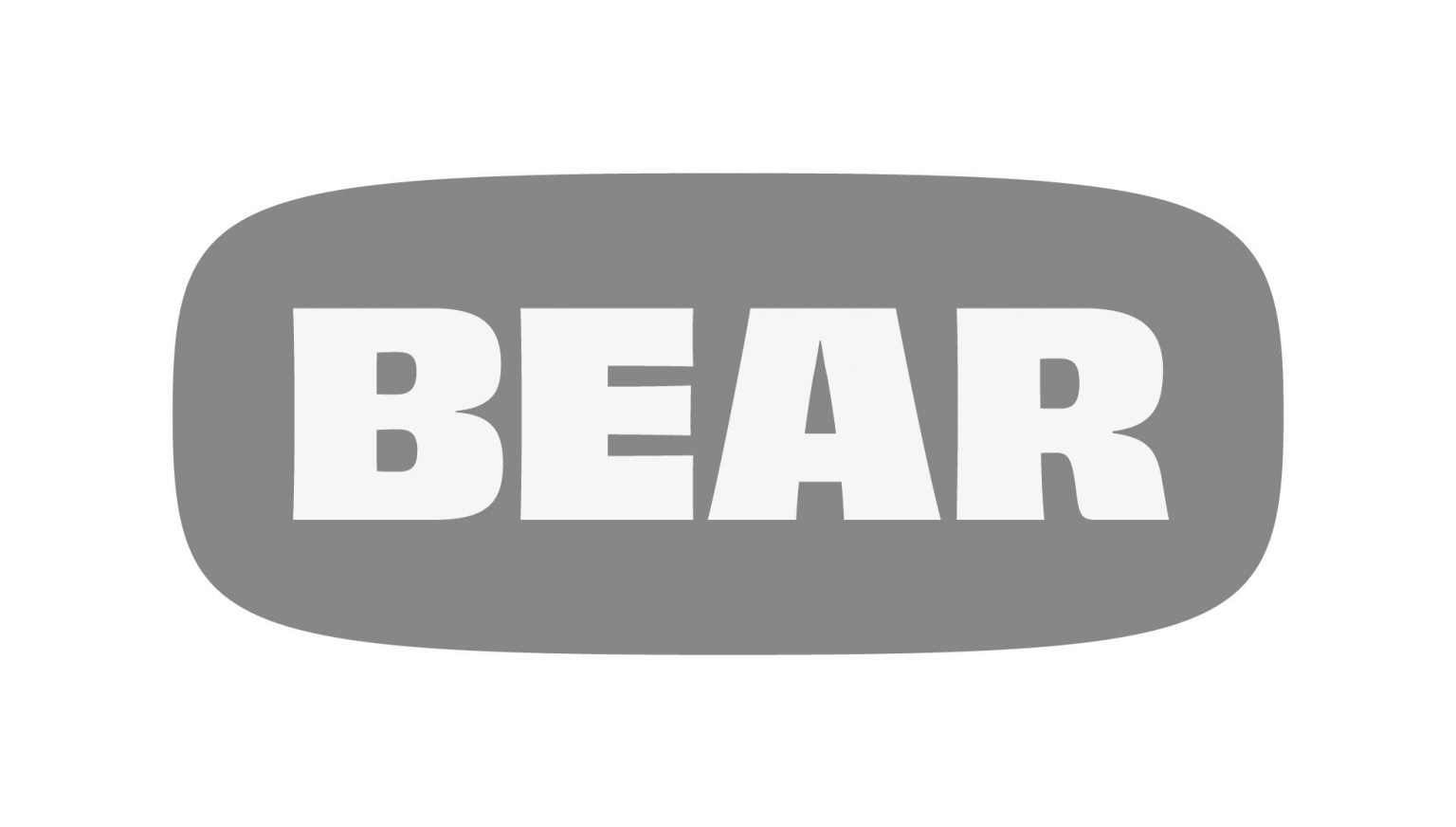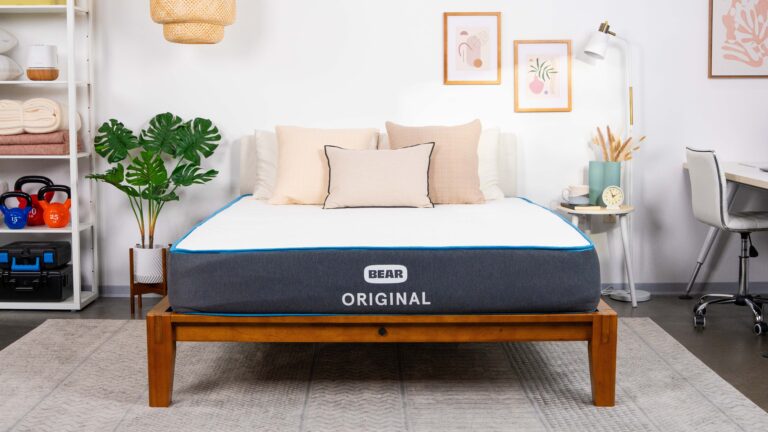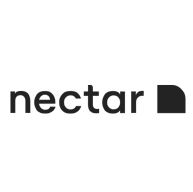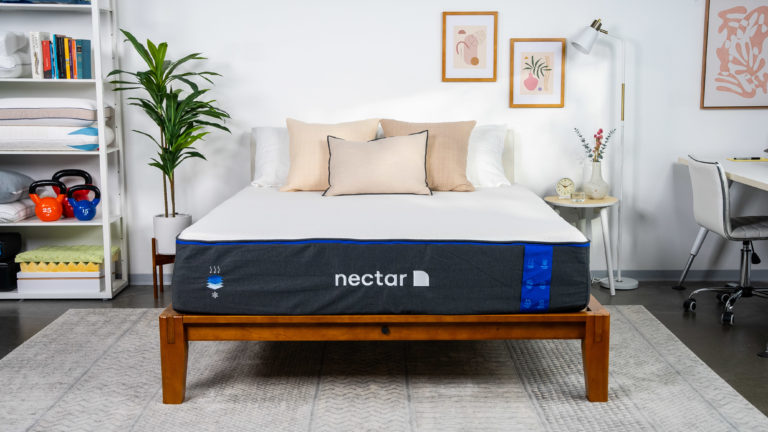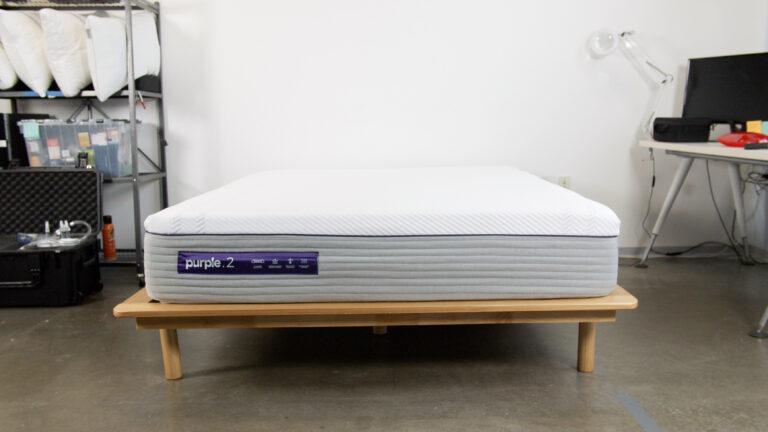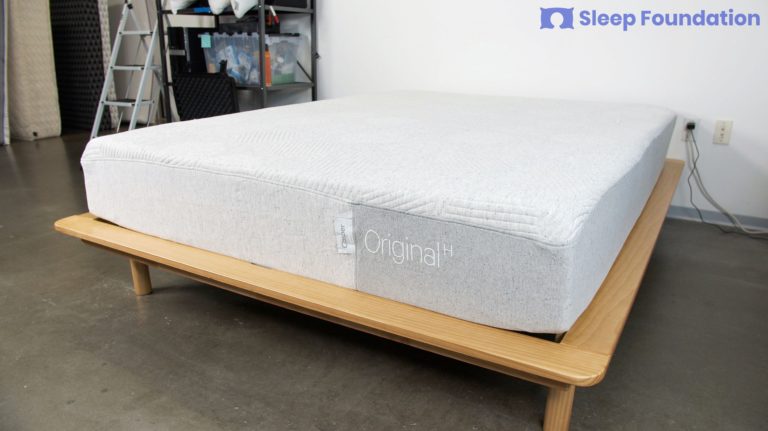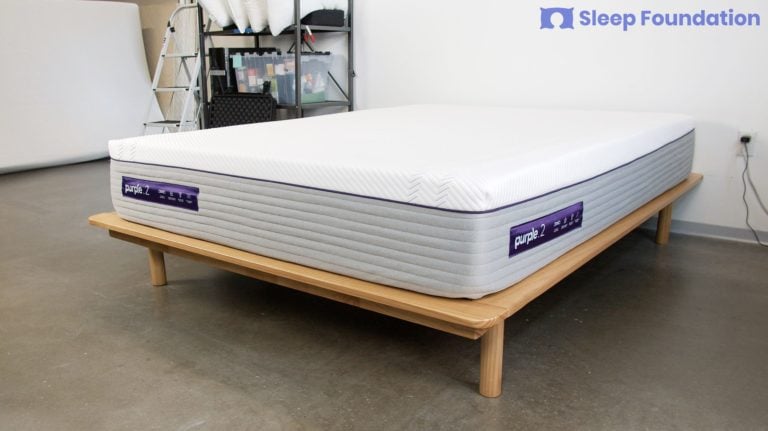When you buy through our links, we may earn a commission. Products or services may be offered by an affiliated entity. Learn more.
Bear vs. Nectar Mattress Comparison
There’s no shortage of options if you’re in the market for a new mattress. In fact, at times, the abundance of choices can be downright overwhelming. For that reason, it’s a big help if you can narrow down to two brands, take a deeper look at them, and use the comparison to make an informed purchase.
If you’ve landed on Bear and Nectar for that comparison, you can take comfort in knowing that both companies have built a solid reputation for supportive mattresses at competitive prices.
Bear first launched with their original all-foam Bear Original and have since expanded their offerings to include another all-foam bed, the Bear Pro, and the Bear Star Hybrid. Nectar Sleep also started with just one option — the Nectar Mattress — and have more recently developed the Nectar Premier and Nectar Premier Copper. Each of Nectar’s beds is an all-foam model, so of these two brands, only Bear offers a hybrid.
Our in-depth review of Bear versus Nectar mattresses covers the critical information that you need to be a discerning customer. Ultimately, neither Bear or Nectar is best for everyone; instead, by comparing factors like sizing, pricing, performance, and customer service policies, you can make a decision that best matches with what you need to be satisfied with a new mattress.
Quick Look
We’ve worked hard to show you which mattresses are the best fit for you. Check out our full mattress guides listed below!
$649 – $1,373
$649 – $1,249
Medium Firm (6), Firm (7)
Medium Firm (6)
- Celliant textile in the cover supports cool and restorative sleep
- High-performance foam and hybrid options
- Combination of foams that cushion the body's pressure points
- Thick layers of memory foam provide significant pressure relief
- Breathable, moisture-wicking covers
- 365-night sleep trial and lifetime warranty
- 120 nights (30-night break-in period)
- Lifetime warranty
- 365 nights
- Lifetime, Limited
Sizing and Weight Options
A logical starting point for comparing the Bear versus Nectar mattresses is their dimensions because, though straightforward, this information can factor into the process of finding the optimal mattress.
The height of a mattress affects the pocket depth that you need for your fitted sheets. It also influences how easy it is to get in and out of bed, especially when you take into account the height of the bed frame that you plan to use.
Selecting the right mattress size is important to ensure that your bed is roomy enough for you (and your bed partner if you share a bed) without taking up all the available floor space in your bedroom.
While the weight of a mattress doesn’t have as much day-to-day importance, it does impact how easy it is to move the mattress and in some cases can determine the type of bed frame that you need to make sure the mattress is properly supported.
Bear
Nectar
Height
10″Size Options
Twin, Twin XL, Full, Queen, King, California King, Split KingHeight
12″Size Options
Twin, Twin XL, Full, Queen, King, California King, Split KingBear Pro
Height
12″Size Options
Twin, Twin XL, Full, Queen, King, California KingHeight
13″Size Options
Twin, Twin XL, Full, Queen, King, California King, Split KingHeight
13″Size Options
Twin, Twin XL, Full, Queen, King, California King, Split KingHeight
14″Size Options
Twin, Twin XL, Full, Queen, King, California King, Split KingBy and large, the offerings from Bear and Nectar are similar with regard to their dimensions. All of their mattress options are available in the six standard sizes. The all-foam offerings from both companies have comparable heights and weights.
The biggest difference comes from the Bear Star Hybrid, which is the only model among the two product lines that includes a coil-based layer. The innerspring coils weigh considerably more than foam, which makes the Bear Star Hybrid the heaviest of these beds. In addition, the hybrid is taller. While standard fitted sheets should have no problem fitting on the Bear Star Hybrid, its 13-inch profile is noticeably taller than the 10-inch Bear Original or 12-inch Nectar.
Because of the commonalities between the dimensions of the Bear and Nectar mattresses, sizing is unlikely to be the make-or-break issue for most shoppers. That said, potential customers should carefully consider the ideal mattress size for their bedroom and whether the added height and weight of a hybrid is a positive, negative, or neutral factor in their case.
Construction and Materials Comparison
A fundamental part of comparing mattresses is looking closely at how they are constructed. The materials used in a mattress and the way its layers are organized have a tremendous effect on how it performs and ultimately on customer satisfaction.
To describe how a mattress is built, we look at both its comfort system and support core. The comfort system is made up of the topmost layer (or layers) that most directly shape how a person perceives the feel of the mattress. The support core is the base layer (or layers) upon which the comfort system rests.
In foam mattresses, the comfort system and support core are all made with memory foam, polyfoam, latex, or other materials (like cotton or polyester). In a hybrid mattress, the support core is made with innerspring coils, and the comfort system can employ a range of materials including foam, micro-coils, latex, and/or other fibers.
Bear
Bear initially launched with just one mattress and later, building on their increasingly well-known brand identity, unveiled two other mattress options.
One common feature among all three Bear mattresses is the Celliant cover. This is a specialty textile that is able to draw heat away from the body and convert it and reflect it back as infrared energy. For sleepers, this serves two purposes. It can decrease the buildup of heat around the body, and more importantly for many sleepers, studies have demonstrated that infrared energy may be able to help the muscles and other tissues recover overnight.
The Bear Original is the company’s first offering, and it features a solid all-foam design with a Firm (7) feel. Underneath the Celliant cover, the Bear Original has three layers:
- 2 inches of graphite-gel-infused memory foam
- 2 inches of transition polyfoam
- 6 inches of base polyfoam
In this design, the memory foam layer provides tailored support to pressure points, and its gel infusion aids in the fight against heat retention. The transition polyfoam layer halts excess sinkage into the bed, which can be uncomfortable and put stress on the support core. The polyfoam at the bottom of the Bear Original offers a reliable base and helps hold up the edges of the mattress.
The Bear Pro is another all-foam mattress with a Medium Firm (6) feel, but this model has four interior layers:
- 1 inch of copper-infused polyfoam
- 1.5 inches of gel-infused memory foam
- 2.5 inches of transition polyfoam
- 7 inches of base polyfoam
Copper is infused into the top layer in order to take advantage of its antimicrobial and temperature-regulating properties, and gel-infused memory foam amps up the bed’s ability to conform to the body and promote spinal alignment. At the same time, the transition and base polyfoam layers give the bed a dependable design and a hedge against feeling stuck in the mattress.
A distinct design approach of the Bear Star Hybrid is evident in its interior construction. This mattress has five components:
- Copper-infused memory foam
- Transition polyfoam
- Pocketed coils
- High-density base polyfoam
The Bear Star Hybrid has a Medium Firm (6) feel, and its bounce from the combination of coils and responsive polyfoam helps keep sleepers from dipping too far into the mattress. A reinforced perimeter in the support core improves the Bear Star Hybrid’s edge support, and the copper-infused top layer along with the airflow-permitting coils facilitate solid temperature regulation.
Nectar
The flagship product from Nectar Sleep is the Nectar Mattress, which has found significant popularity among online mattress shoppers. A strength of the Nectar Mattress is its ability to provide many of the benefits of memory foam without falling victim to its potential downsides. This goal is achieved in large part thanks to the build of the mattress.
The cover of the Nectar is made from a breathable blend of polyester, polyethylene, and nylon. Beneath cover are three individual layers:
- 2 inches of gel-infused memory foam
- 3 inches of transitional polyfoam
- 7 inches of high-density base polyfoam
The Nectar delivers solid pressure relief and motion isolation. The transitional foam resists the deep sagging and slow rebound of traditional memory foam, allowing the mattress to have a Medium Firm (6) feel and prevent any quicksand-like feeling. The gel included in the comfort layer helps fight heat buildup, and the high-density base foam improves sturdiness and durability.
The Nectar Premier is one of Nectar’s newest mattress models. This all-foam model is very similar to the flagship mattress, apart from a couple of notable differences. The Premier has three layers.
- 3 inches of gel-infused memory foam with phase-change material
- 3 inches of transitional polyfoam
- 7 inches of base polyfoam
The 13-inch Premier measures 1 inch thicker than the flagship Nectar Mattress, but both offer a medium-firm feel. The Premier also features phase-change material in its comfort layer. The phase-change material is engineered to dissipate body heat and regulate temperature, so this model should sleep cooler than the Nectar Mattress.
Lastly, Nectar offers the Premier Copper, which shares a similar design with the standard Premier. This model includes three individual layers:
- 4 inches of gel-infused memory foam with phase-change material
- 1 inches of transitional polyfoam
- 9 inches of base polyfoam
At 14 inches thick, the Premier Copper is Nectar’s tallest mattress – but like the other two models, this one has a medium firm feel and shouldn’t sink too much. The Premier Copper’s cover is infused with copper fibers, which have natural cooling properties. Of Nectar’s three mattresses, the Premier Copper should offer the best temperature control.
In-Depth Ratings
Making a well-informed choice between the Bear and Nectar mattresses, or any mattresses for that matter, requires knowing what to look for. Unfortunately, mattress marketing and hype can sometimes cause shoppers to take their eyes off the ball. Certain elements of mattress performance are most directly related to customer satisfaction; focusing on these and which among them are most important to you can help you select your best mattress.
- Durability: A durable mattress means better sleep, financial savings, and not having to go through the mattress buying process again anytime soon. If a bed starts to wear out, it won’t support your body properly, so opting for a mattress with quality components can be a real boost for your long-term sleep. Mattresses with well-thought-out construction and solid materials have the best longevity.
- Motion Isolation: Motion transfer is how we describe the sensation when you can feel the bed shake or move when your bed partner tosses and turns or gets out of bed. Motion isolation, which tends to be highest in memory foam mattresses, is the opposite and keeps the movement of each sleeper contained to their side. This is obviously most useful for couples or people who share their bed with larger dogs, and it is particularly important to anyone who finds that they are stirred awake easily during the night.
- Sex: Beyond just supporting good sleep, a mattress can contribute to an active sex life. Intimate activities are often punctuated by rapid movements, and a mattress needs to have enough cushioning to prevent harsh impact with the bed while at the same time facilitating movement on its surface. This balance is best accomplished when a mattress has bounce; without bounce, there’s a greater chance of feeling stuck in the bed, especially if it has a plush feel.
- Temperature Neutrality: Even people who like to get cozy don’t want to wake up in a sweat. Some mattress designs and materials lead to heat retention around the body and in the mattress, and this can be a major problem for those who already tend to sleep hot. Overheating is most often caused by very plush and contouring mattresses – especially those made with traditional memory foam – that surround the body and limit cooling airflow from reaching the skin. Special features or materials may be incorporated into a mattress to help it maintain a neutral temperature.
- Pressure Relief: Depending on your body shape and sleeping position, some areas of the body can be more susceptible to aches and pains. This can happen from a sharp impact with the mattress or a lack of spinal support. Common areas of pain include the lower back, hips, and shoulders. A mattress that can cushion the joints and contour to the body and accommodate the spine can relieve pressure and make sleep more restful and less painful.
- Off-gassing: When a bed is prepared for mattress-in-a-box shipping, it is compressed and packed in plastic soon after being manufactured. Residual volatile organic compounds (VOCs) from manufacturing may be trapped in the plastic, so when you open up the packaging, those VOCs can be released (off-gassed). The VOCs aren’t harmful to your health, but they can give off a noticeable odor. Foam materials tend to have the most smell, especially if they are lower-quality foams, but even with bad off-gassing, the smell usually goes away within a week.
- Ease of Movement: The design of a mattress and its materials help determine how easy it is to move on the bed, no matter whether it’s a minor adjustment in your sleeping posture or fully getting up and out of bed. If a mattress is plush and has minimal bounce, there’s a higher risk that it will have a quicksand feeling with which every movement takes serious effort. On the contrary, medium or firmer beds with lots of bounce make it simple and smooth to move on top of the mattress.
- Edge Support: Many sleepers gravitate toward the perimeter of their mattress at night, and some people want to sit on the edge of their mattress as they put on their shoes or otherwise prepare to get in or out of bed. If a mattress has weak edges, these actions may cause a person to feel unsupported or even fall out of bed. This problem of weak edge support is usually most pronounced on beds that are very soft and have deep compression in their comfort layers. Mattresses with reinforced edges, including many hybrids, provide a more robust feeling that gives the mattress sturdiness across its entire surface.
Bear
Nectar
In-Depth Pricing
Though there’s a host of variables to reflect on when making a mattress purchase, there’s no getting around the bottom line. Finding a mattress that fits your budget is essential, but there’s no simple formula that dictates what a mattress costs. Instead, the price tag can change based on several factors:
- The type and quality of materials
- The thickness of the mattress and its individual layers
- The use of specialty or eco-friendly materials
- The addition of unique features or design elements
- The location where the mattress is made (in the USA or another country)
Remember that the sticker price for mattresses is a starting point; in most cases, discounts from promotions or sales events will bring down the retail prices listed in the following tables.
Bear
Sleep Foundation Special Offer
35% off + 2 free pillows at Bear. Code: SF35
Nectar
Sleep Foundation Special Offer
Up to 40% off mattresses at Nectar
The lowest-priced mattress offered by these two companies is the Bear Original, which has a very competitive price point that comes in lower than most all-foam beds with a memory foam layer. While the sticker price of the Nectar is higher, the company tends to offer significant discounts that can make its price similar to that of the Bear Original.
The Bear Pro is the next most affordable option, and it offers some extra features without a huge price jump. The Nectar Premier and Premier Copper carry higher prices, although it may be worth it for shoppers who want a thick comfort layer and above-average temperature regulation.
The Bear Star Hybrid has a sticker price that is slightly higher than the Nectar Premier or Premier Copper. On average, hybrids tend to cost more than all-foam beds, but the Bear Star Hybrid has a relatively low price point compared to similarly built models offered by other online brands.
Overall, while Bear tends to have an advantage based on its retail and MSRP both of these brands provide solid value. Their products have competitive pricing, especially considering some of their high-quality components like the Celliant textile or thick layers of memory foam.
Trials, Warranty, and Delivery
In addition to finding the right mattress for your comfort and support needs, you’ll want to make sure that you have a handle on all the logistics for buying a mattress from either Bear or Nectar. Online mattress shopping can involve different policies than you’ll find in brick-and-mortar stores, and this section introduces the key topics and how they apply in the case of these two brands.
Shipping
Free shipping is normally included when you buy a mattress online. Standard shipping involves compressing the mattress, sealing it in plastic, and delivering it to your front door in a cardboard box. The mattress is not damaged in any way by being compressed, and as soon as it is removed from the packaging, it begins to regain its full size. All you have to do to install the mattress is carry the box inside, take out the mattress, and carefully cut away the plastic. For safety’s sake, it’s best to have two or more people lift the box and position the mattress.
Some brands offer White-Glove delivery, which means that a team of people comes to your home to install your new mattress and haul away your old one. This service frequently comes with an extra charge and may not be available in all locations.
Bear Shipping Policies
For all three of their mattresses, Bear provides free standard shipping to the contiguous 48 U.S. states and Canada. For customers in Alaska and Hawaii, standard shipping comes with an extra charge.
White-Glove delivery for Bear mattresses is only available in the contiguous U.S. Installation of a Bear mattress alone costs $100. Installation plus haul-away of an old mattress costs $150.
Nectar Shipping Policies
Nectar includes free shipping for its mattresses to addresses in the contiguous United States. An extra charge applies to deliveries to Alaska and Hawaii.
White-Glove delivery for either Nectar mattress is offered for a charge of $149 and includes both installation of the Nectar and removal of an old mattress.
Sleep Trial and Returns
Some people worry about buying a mattress online when they don’t have a chance to first feel it out in person. To resolve this concern, online sellers almost always provide a sleep trial, which is a type of return policy that lets customers try out the mattress with the ability to return it if they don’t like it. Most sleep trials last for at least 100 nights and offer free returns and a full refund.
Bear Sleep Trial and Return Policy
For all of the mattresses from Bear, customers have 120 nights to try the mattress in their own home. A full refund is available if you aren’t satisfied, though Bear requires a 30-night break-in period before refunds can be initiated.
Nectar Sleep Trial and Return Policy
Nectar also offers a full-year sleep trial. The company requires that you test out the mattress for 30 nights, and after those first 30 nights, the 365-night return window begins. This allows customers an extended period to try any Nectar model with the option to receive a full refund if they aren’t happy with it.
Warranty
A mattress warranty provides recourse in case something goes unexpectedly wrong and the mattress breaks down prematurely. These warranties cover defects in materials and craftsmanship, but they don’t cover accidental damage (like spills or pet accidents) or normal, gradual wear-and-tear. Important aspects of a warranty include both how long it lasts (the “term”) and the company’s obligations if there is a defect (the “remedy”).
Bear Mattress Warranty
All Bear mattresses have a lifetime warranty covering defects in materials and manufacturing. These warranties provide for repair or replacement if there is a defect. Return transportation costs are free if Bear determines that a defect exists.
Nectar Mattress Warranty
Nectar offers a Forever Warranty that provides coverage for defects for as long as you own the mattress. During the first 10 years, Nectar will replace a defective mattress at no cost to the customer. Nectar covers shipping costs during this period. Starting in year 11, Nectar will repair or replace the mattress, and the customer is responsible for a $50 shipping charge each way. That shipping charge is waived by the company if the mattress is confirmed to have a defect.
Bear
Sleep Trial & Returns
120 nights (30-night break-in period)
Warranty
Lifetime warranty
Shipping
Free to contiguous U.S.
Nectar
Sleep Trial & Returns
365 nights
Warranty
Lifetime, Limited
Shipping
Free to contiguous U.S.

Still have questions?
Our product experts have extensive experience testing just about every sleep product on the market. Send an email to [email protected] or call us at (877) 672-8966 with your questions and we'll help you find exactly what you're looking for.

